第二课第一周大作业--构建和评估一个线性风险模型
Posted Tina姐
tags:
篇首语:本文由小常识网(cha138.com)小编为大家整理,主要介绍了第二课第一周大作业--构建和评估一个线性风险模型相关的知识,希望对你有一定的参考价值。
之前教程:
第二课第一周第1节-AI用于医学预后简介
第二课第一周第2节-做医学预后,你需要掌握什么?
第二课第一周第3-4节-什么是预后?
第二课第一周第4-7节 医学预后案例欣赏+作业解析
第二课第一周第8节 风险得分计算+作业解析
第二课第一周第9-11节 评估预后模型+作业解析
第一周课程完美结束,让我们来预测糖尿病视网膜病变的风险
作业地址:gongzhonghao 相关文章上领取
outline
大概内容如下
- 1. Import Packages
- 2. Load Data
- 3. Explore the Dataset
- 4. Mean-Normalize the Data
- 5. Build the Model
- 6. Evaluate the Model Using the C-Index
- 7. Evaluate the Model on the Test Set
- 8. Improve the Model
- 9. Evalute the Improved Model
overview
在本作业中,您将使用逻辑回归构建糖尿病患者视网膜病变的风险评分模型。
在开发模型时,我们将了解以下概念:
- Data preprocessing
- Log transformations
- Standardization
- Basic Risk Models
- Logistic Regression
- C-index
- Interactions Terms
Diabetic Retinopathy
视网膜病变是一种眼部疾病,会导致称为视网膜的眼部血管发生变化。
这通常会导致视力改变或失明。
众所周知,糖尿病患者患视网膜病变的风险很高。
Logistic Regression
逻辑回归是用于预测二元结果概率的适当分析。在我们的案例中,这将是患有或不患有糖尿病视网膜病变的可能性。
逻辑回归是最常用的二元分类算法之一。它用于找到最佳拟合模型来描述一组特征(也称为输入、独立、预测或解释变量)和二元结果标签(也称为输出、依赖或响应)之间的关系。
逻辑回归具有输出预测始终在 [ 0 , 1 ] [0,1] [0,1] 范围内的特性
1 import packages
import numpy as np
import pandas as pd
import matplotlib.pyplot as plt
2 load data
from utils import load_data
# This function creates randomly generated data
# X, y = load_data(6000)
# For stability, load data from files that were generated using the load_data
X = pd.read_csv('X_data.csv',index_col=0)
y_df = pd.read_csv('y_data.csv',index_col=0)
y = y_df['y']
这里加载官方提供的数据,如果你没有下载到,也可以使用随机生成数据
X 和 y 是 Pandas DataFrames,包含 6,000 名糖尿病患者的数据。
3 explore the dataset
The features (X) include the following fields:
- Age: (years)
- Systolic_BP: Systolic blood pressure (mmHg)收缩压
- Diastolic_BP: Diastolic blood pressure (mmHg)舒张压
- Cholesterol: (mg/DL) 胆固醇
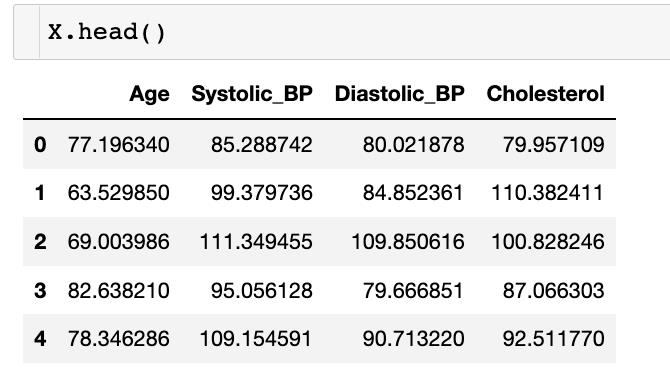
target (y) 是患者是否发生视网膜病变的指标
- y = 1:患者患有视网膜病变。
- y = 0:患者没有视网膜病变。
在我们建立模型之前,让我们仔细看看我们的训练数据的分布。为此,我们将使用 75/25 拆分将数据拆分为训练集和测试集。
from sklearn.model_selection import train_test_split
X_train_raw, X_test_raw, y_train, y_test = train_test_split(X, y, train_size=0.75, random_state=0)
for col in X.columns:
X_train_raw.loc[:, col].hist()
plt.title(col)
plt.show()
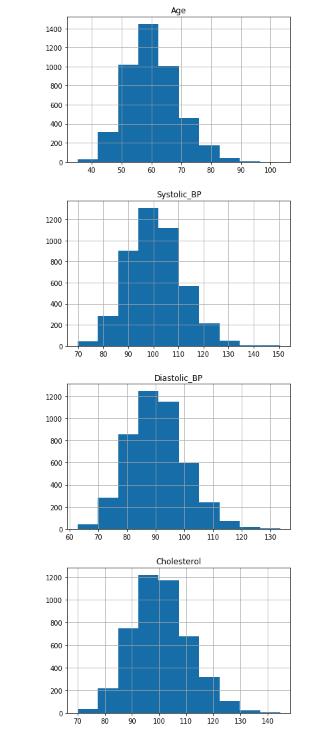
正如我们所看到的,这些分布通常呈钟形分布,但有轻微的向右偏斜。
许多统计模型假设数据是正态分布的,形成一个对称的高斯钟形(没有偏斜),更像下面的例子。
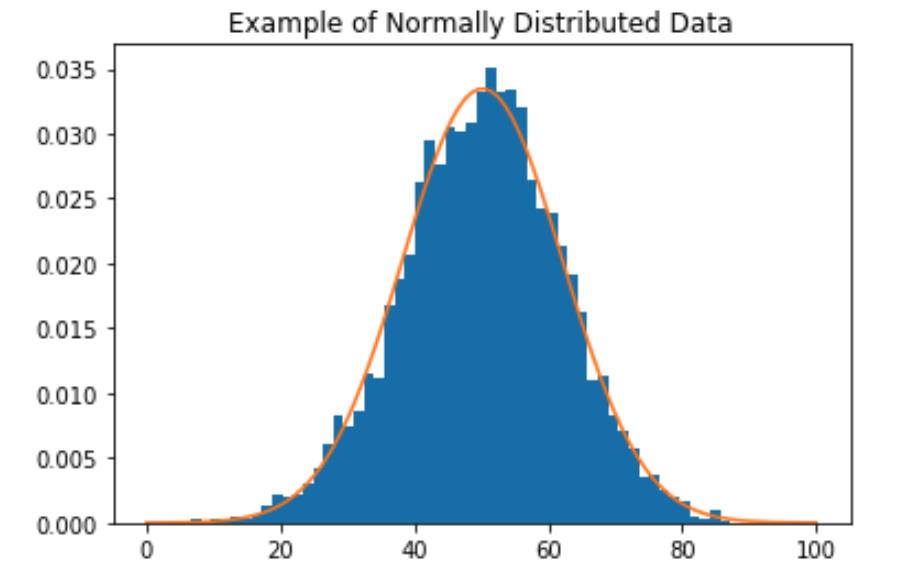
我们可以通过消除偏斜将数据转换为更接近正态分布。消除偏斜的一种方法是将log函数应用于数据。让我们绘制特征变量的log,看看它是否产生了预期的效果。
for col in X_train_raw.columns:
np.log(X_train_raw.loc[:, col]).hist()
plt.title(col)
plt.show()
这里使用了np.log()

对比年龄的分布,取 log 后我们可以看到数据更加对称
4 Mean-Normalize the data
现在让我们 transform 我们的数据,使分布更接近标准正态分布。
首先,我们将使用 log 转换从分布中消除一些偏斜。然后我们将“标准化”分布,使其均值为零,标准差为 1。
编写一个函数,首先去除数据中的一些偏斜,然后标准化分布,以便对于每个数据点
𝑥
𝑥
x ,
x
‾
=
x
−
m
e
a
n
(
x
)
s
t
d
(
x
)
\\overlinex = \\fracx - mean(x)std(x)
x=std(x)x−mean(x)
请注意,我们 test data 是“看不见的”数据。
- 这意味着我们不可能求到它的整体均值和方差,但可以使用训练数据来计算这些值,然后将它们用于标准化训练和测试数据。
- 更多讨论,请参阅这篇文章为什么我们需要重用训练参数来transform测试数据。
def make_standard_normal(df_train, df_test):
"""
In order to make the data closer to a normal distribution, take log
transforms to reduce the skew.
Then standardize the distribution with a mean of zero and standard deviation of 1.
Args:
df_train (dataframe): unnormalized training data.
df_test (dataframe): unnormalized test data.
Returns:
df_train_normalized (dateframe): normalized training data.
df_test_normalized (dataframe): normalized test data.
"""
### START CODE HERE (REPLACE INSTANCES OF 'None' with your code) ###
# Remove skew by applying the log function to the train set, and to the test set
df_train_unskewed = np.log(df_train)
df_test_unskewed = np.log(df_test)
#calculate the mean and standard deviation of the training set
mean = df_train_unskewed.mean(axis=0)
stdev = df_train_unskewed.std(axis=0)
# standardize the training set
df_train_standardized = (df_train_unskewed - mean) / stdev
# standardize the test set (see instructions and hints above)
df_test_standardized = (df_test_unskewed - mean) / stdev
### END CODE HERE ###
return df_train_standardized, df_test_standardized
通过测试可以看到,经过标准化后,训练数据的均值为1,方差为0,测试数据集上虽然不是0和1,但也很接近。
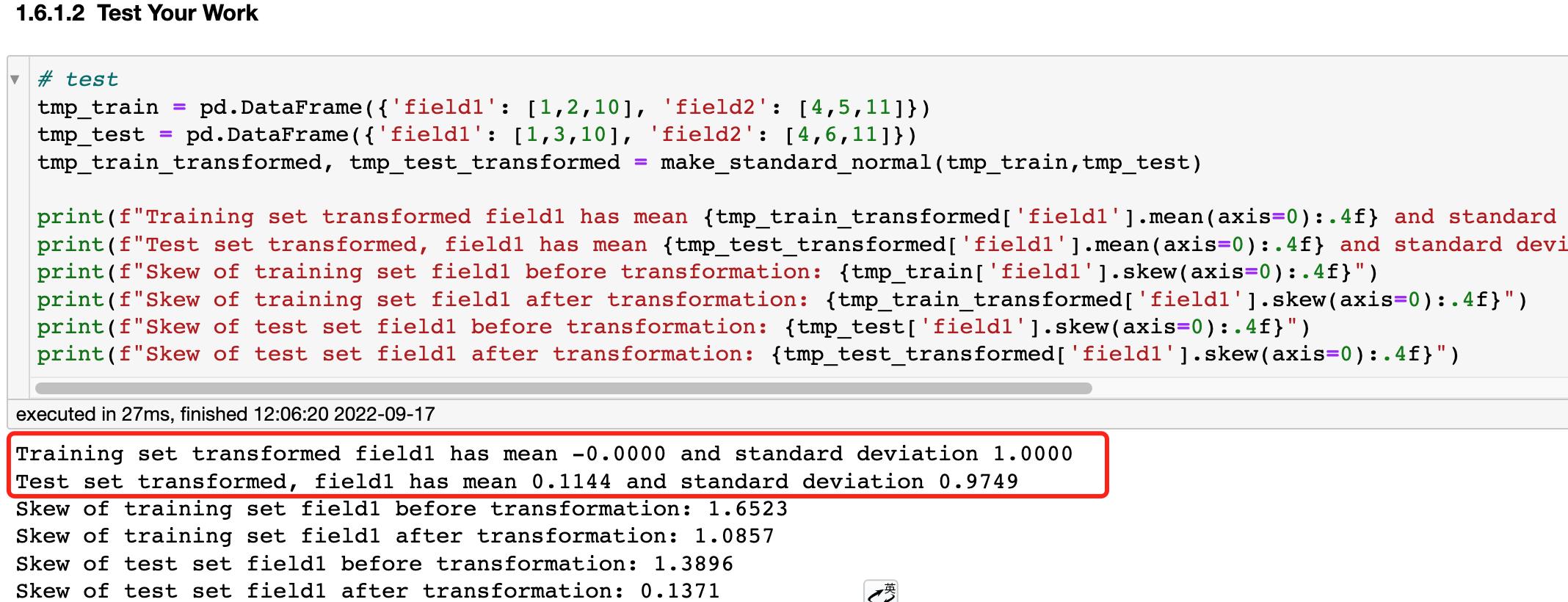
把我们的X_train, X_test进行标准化
X_train, X_test = make_standard_normal(X_train_raw, X_test_raw)
经过数据转换后的数据分布👇

7 build the model
现在我们准备通过使用我们的数据训练逻辑回归来构建风险模型。
def lr_model(X_train, y_train):
### START CODE HERE (REPLACE INSTANCES OF 'None' with your code) ###
# import the LogisticRegression class
from sklearn.linear_model import LogisticRegression
# create the model object
model = LogisticRegression()
# fit the model to the training data
model.fit(X_train,y_train)
### END CODE HERE ###
#return the fitted model
return model
model_X = lr_model(X_train, y_train)
8 评估模型
我们使用c-index评估模型
- c-index 衡量风险评分的辨别力。
- 直观地说,较高的 c 指数表明模型的预测与一对患者的实际结果一致。
- c-index的公式是
KaTeX parse error: Undefined control sequence: \\mbox at position 2: \\̲m̲b̲o̲x̲cindex = \\fra…
- 允许的配对是一对具有不同结果(y=0和y=1)的患者。
- concordant配对是允许的配对,其中风险评分较高的患者也有较差的结果。
- ties 是允许配对中,其中患者具有相同的风险评分。
def cindex(y_true, scores):
'''
Input:
y_true (np.array): a 1-D array of true binary outcomes (values of zero or one)
0: patient does not get the disease
1: patient does get the disease
scores (np.array): a 1-D array of corresponding risk scores output by the model
Output:
c_index (float): (concordant pairs + 0.5*ties) / number of permissible pairs
'''
n = len(y_true)
assert len(scores) == n
concordant = 0
permissible = 0
ties = 0
### START CODE HERE (REPLACE INSTANCES OF 'None' with your code) ###
# use two nested for loops to go through all unique pairs of patients
for i in range(n):
for j in range(i+1, n): #choose the range of j so that j>i
# Check if the pair is permissible (the patient outcomes are different)
if y_true[i] != y_true[j]:
# Count the pair if it's permissible
permissible =permissible + 1
# For permissible pairs, check if they are concordant or are ties
# check for ties in the score
if scores[i] == scores[j]:
# count the tie
ties = ties + 1
# if it's a tie, we don't need to check patient outcomes, continue to the top of the for loop.
continue
# case 1: patient i doesn't get the disease, patient j does
if y_true[i] == 0 and y_true[j] == 1:
# Check if patient i has a lower risk score than patient j
if scores[i] < scores[j]:
# count the concordant pair
concordant = concordant + 1
# Otherwise if patient i has a higher risk score, it's not a concordant pair.
# Already checked for ties earlier
# case 2: patient i gets the disease, patient j does not
if y_true[i] == 1 and y_true[j] == 0:
# Check if patient i has a higher risk score than patient j
if scores[i] > scores[j]:
#count the concordant pair
concordant = concordant + 1
# Otherwise if patient i has a lower risk score, it's not a concordant pair.
# We already checked for ties earlier
# calculate the c-index using the count of permissible pairs, concordant pairs, and tied pairs.
c_index = (concordant + (0.5 * ties)) / permissible
### END CODE HERE ###
return c_index
我们在上节课中,已经学习了c-index的理论基础,这里直接给代码,很好理解。
9 Evaluate the Model on the Test Set
使用 predict_proba 获得测试数据的概率。
scores = model_X.predict_proba(X_test)[:, 1]
c_index_X_test = cindex(y_test.values, scores)
print(f"c-index on test set is c_index_X_test:.4f")
out: c-index on test set is 0.8182
由于线性回归模型,每个特征都有自己的系数(coefficients),也可以理解为每个特征的权重,我们把系数画出来,看哪个特征对结果的影响更大
可以使用函数model.coef_计算系数
coeffs = pd.DataFrame(data = model_X.coef_, columns = X_train.columns)
coeffs.T.plot.bar(legend=None);
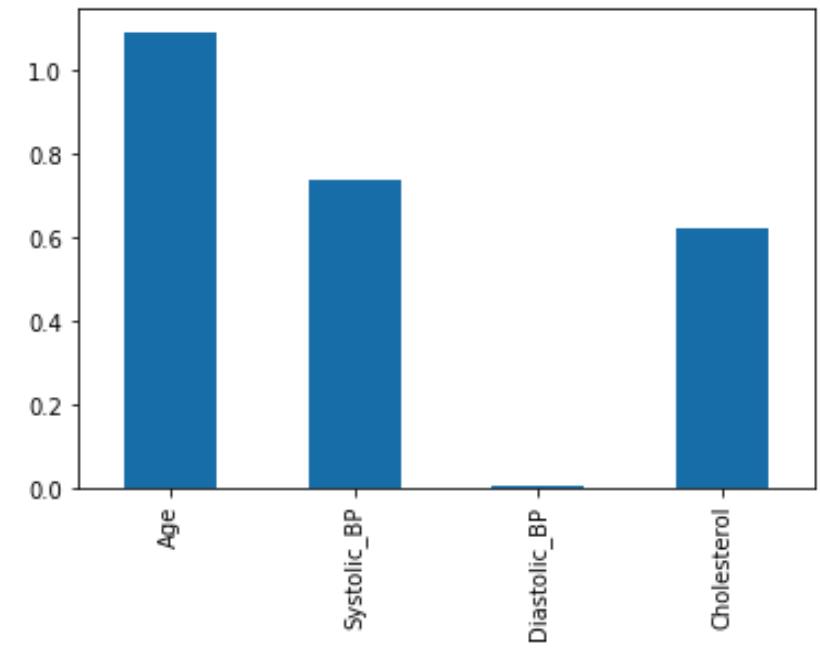
从图上可以看出,年龄对视网膜病变的影响最大。
10 Improve the Model
我们可以通过增加交互项改进模型
- For example, if we have data
x = [ x 1 , x 2 ] x = [x_1, x_2] x=[x1,x2] - We could add the product so that:
x ^ = [ x 1 , x 2 , x 1 ∗ x 2 ] \\hatx = [x_1, x_2, x_1*x_2] x^=[x1,x2,x1∗x2]
把所有的特征进行两两组合,使用乘法而不是加法(上一节课已经讨论过,为什么用乘法)
把组合后的特征都加入X_train中,重新训练模型。我们得到以下所有特征的系数,加入交互项后,c-index=0.8281,提升了一点一点性能。
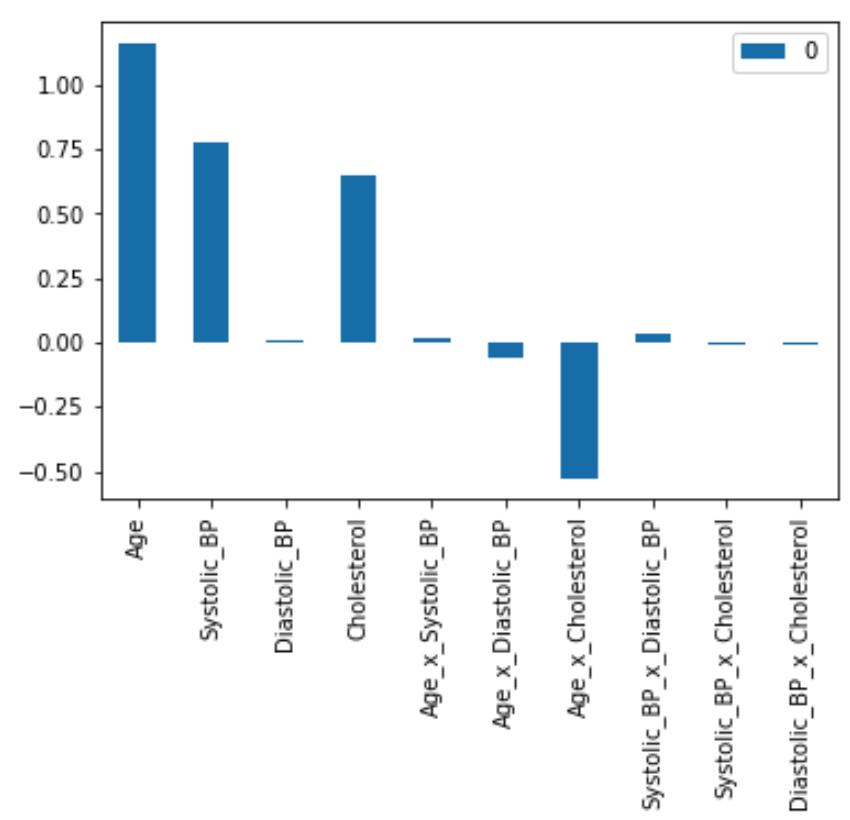
您可能会注意到 Age、Systolic_BP 和 Cholesterol 具有正系数。这意味着这三个特征的值越高,疾病的预测概率就越高。您还可能注意到年龄 x 胆固醇的交互作用具有负系数。这意味着年龄 x 胆固醇乘积的较高值会降低疾病的发病概率。
这部分代码略,详情自行下载。
文章持续更新,可以关注微信公众号【医学图像人工智能实战营】获取最新动态,一个关注于医学图像处理领域前沿科技的公众号。坚持已实践为主,手把手带你做项目,打比赛,写论文。凡原创文章皆提供理论讲解,实验代码,实验数据。只有实践才能成长的更快,关注我们,一起学习进步~
我是Tina, 我们下篇博客见~
白天工作晚上写文,呕心沥血
觉得写的不错的话最后,求点赞,评论,收藏。或者一键三连

以上是关于第二课第一周大作业--构建和评估一个线性风险模型的主要内容,如果未能解决你的问题,请参考以下文章